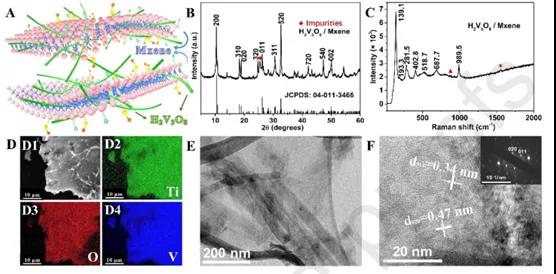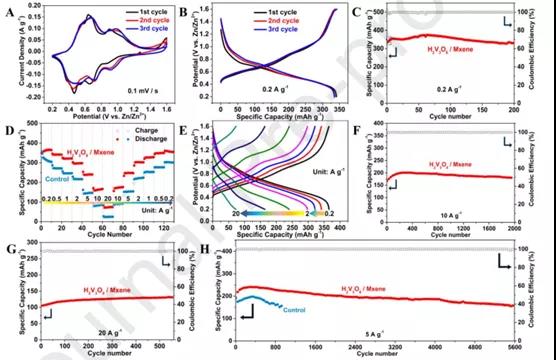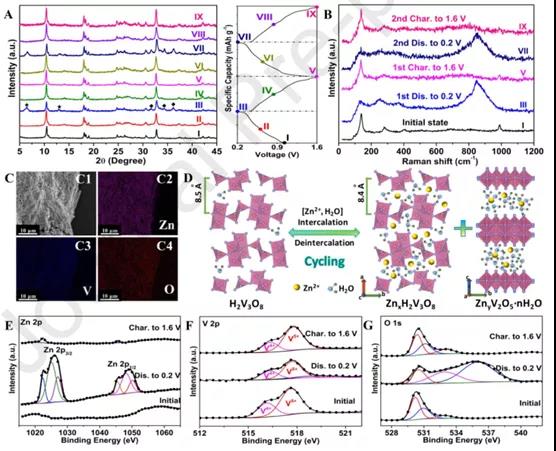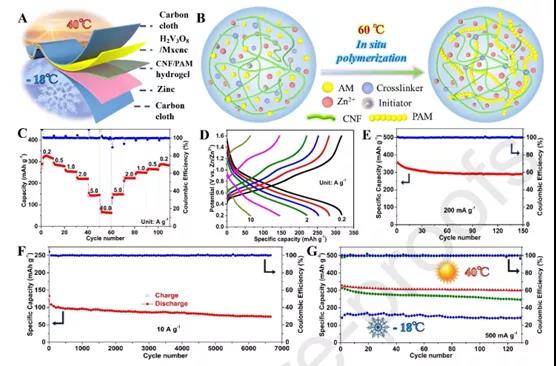CEJ: High-stability V-based oxide/MXene used in water-based zinc ion batteries
QQ Academic Group: 1092348845
Detailed


Lithium-ion batteries (LIBs) have high energy density and long cycle life, and have been widely used in electric vehicles and wearable electronic devices. However, in recent years, many accidents such as the spontaneous explosion of mobile phones and the spontaneous combustion of electric vehicles are related to the organic electrolyte in LIBs. Therefore, safety factors and limited lithium resources have prompted people to explore high-safety and low-cost water-based rechargeable metal ion batteries. Rechargeable water-based zinc-ion batteries (RAZIBs), as a kind of water-based electrolyte batteries, have great potential in large-scale energy storage applications, and because of their outstanding stability in water, they have a low redox potential (-0.762 V vs. Standard hydrogen electrode) and high capacity (820 mAh g-1) have received extensive attention.
Up to now, vanadium-based (V)-based composites have been extensively studied as cathode materials for aqueous zinc-ion batteries, thanks to the multivalence, low cost and diverse crystal structure of vanadium. Among them, layered vanadium oxide (H2V3O8) shows excellent electrochemical performance in sodium, magnesium, lithium and zinc ion batteries. However, during the repeated insertion/extraction of Zn2+, its inherent poor conductivity and structural changes lead to poor rate performance and cycle stability.
Therefore, we can combine it with 2D conductive materials to improve structural stability. The 2D nanosheets are in contact with the active material in a "face-to-edge" or "face-to-face" manner, which can promote the rapid transfer of electrons and ions, thereby improving the rate performance. MXene, as a unique 2D material, has a hydrophilic surface and high conductivity, which makes MXene have excellent performance in many non-aqueous battery systems. However, in aqueous zinc-ion batteries, MXene as a highly conductive additive in vanadium-based cathodes has not been reported.

Recently, Professor Changtong Mei of Nanjing Forestry University and Professor Qinglin Wu of Louisiana State University in the United States published a topic in the international high-level academic journal Chemical Engineering Journal: Highly Stable H2V3O8/Mxene Cathodefor Zn-Ion Batteries with Superior Rate Performance and Long Lifespan‘s research paper designed a composite of H2V3O8 and 2DMXene, which has enhanced conductivity and faster electron diffusion rate, resulting in improved rate performance and extended cycle life.


Figure 1. The structure and morphology of H2V3O8 nanowire/MXene composite electrode.

Figure 2. Electrochemical performance test of H2V3O8 nanowire/MXene composite electrode in water-based zinc ion battery.

Figure 3. Electrochemical kinetic analysis of H2V3O8 nanowire/MXene composite electrode.

Figure 4. Analysis of zinc storage mechanism of H2V3O8 nanowire/MXene composite electrode.

Figure 5. Electrochemical performance of the assembled solid-state zinc-ion battery.

In this paper, a new type of H2V3O8/MXene composite was prepared by directly growing non-oriented H2V3O8 nanowires on MXene 2D nanosheets, which was used as a positive electrode material for water-based zinc-ion batteries with high stability. Compared with pure H2V3O8, the prepared composite electrode has a larger specific capacity. At a current density of 0.2 A g-1, it has a reversible capacity of 365.3 mAh g-1 and a higher rate performance. It has a capacity of 73.1 mAh g-1 at a current density of 1, and can perform 5600 stable charge-discharge cycles. 2D MXene not only allows H2V3O8 to grow directly, but also can be combined with H2V3O8 nanowires to form a composite structure with high conductivity. In addition, the assembled flexible solid-state zinc-ion battery can work stably under some extreme conditions (such as -18°C).
Literature link:
https://doi.org/10.1016/j.cej.2020.126737
This information is from the Internet for academic exchanges only. If there is any infringement, please contact us to delete it immediately.
- Previous: The latest science in
- Next: IF 26.8! Permeation ca


 mxene academic
mxene academic
